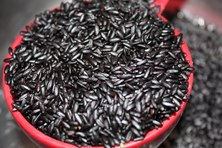|
Have you heard of forbidden rice? Black or purplish in color, this rice is a powerhouse of antioxidants. It’s “forbidden name” comes from it’s status in ancient China as a status symbol for the wealthy and royalty. It was also known as “longevity rice” due to its health value, and was forbidden from anyone of a lower status to eat it. Nowadays it is widely available and can be found at almost any major grocery store. Black rice is high in flavonoid phytonutrients and anthocyanin antioxidants. These are the same antioxidants you find in deep red and purple fruits and vegetables, such as berries, that are known for reducing free radical damage and inflammation, both conditions that cause premature aging and disease. These antioxidants are great for cancer prevention, protection against heart disease and increased brain function, as well as lowering blood pressure. Black rice is also high in fiber which aids in good digestive health as well as keeping your blood sugar balanced and keeping you full. It’s naturally gluten free, contains iron and vitamin E and can help detoxify the liver. As with many other varieties of rice, it can contain some traces of arsenic. Combat this by cooking your rice with a higher water to rice ratio much like the method used to cook pasta. Arsenic is water soluble and will go down the drain. Remember to practice portion control and have your rice with some fat and protein for the best health benefits if you include this grain in your diet. Try my recipes for Black Rice Pilaf, Purple Forbidden Rice Pancakes and Exotic Rice Pudding! Recipes coming soon! Follow me on Facebook for the latest updates!
1 Comment
|
AuthorStevie Winsborrow is a professional chef, functional and integrative nutritionist and holistic health coach, as well as a published author, TV and radio personality and Editor In Chief of Align Body & Soul magazine. Archives
October 2023
|


 RSS Feed
RSS Feed
